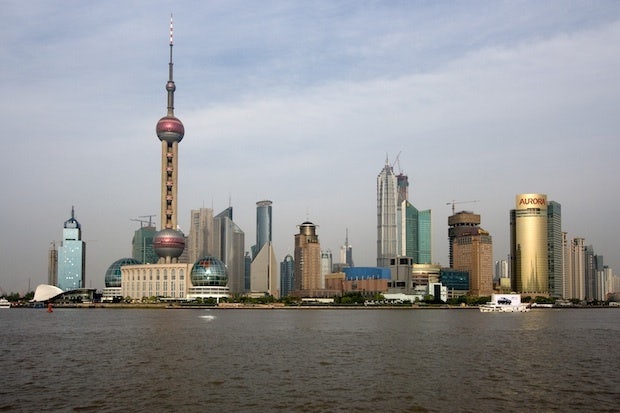370,000 Shanghai Residents Worth 6 Million Yuan (US$949,710)#

According to the recent "Shanghai Wealth Report 2012," published by the Hurun Report and Australia's Gao Fu Wealth Management, Shanghai, mainland China's financial center and a rising star on the global business scene, now has 370,000 residents worth at least 6 million yuan (US$949,710), with business owners, real estate investors and professional investors ranking as the city's wealthiest. The report adds that 140,000 Shanghai residents have assets of 10 million yuan (US$1.6 million) or more, an increase of 6.1 percent over last year and a full 14 percent of China's high net worth individuals. A similar increase of 5.1 percent was seen among the 8,200 "super-rich" residents, whose net worth meets or exceeds 100 million yuan (US$15.8 million). Of the super-rich individuals in Shanghai, the Hurun Report details, 75 percent are business owners, while real estate investors account for 15 percent and professional investors account for 10 percent. “This year’s report," said Rupert Hoogewerf, chairman and chief researcher of the Hurun Report, "shows that property is the biggest source of wealth in Shanghai, while globally, most wealth comes from professional investment."
Still, since China's real estate industry remains on shaky ground and the stock market is far from a source of strength, Hoogwerf added that we should see changes in the makeup of upcoming rich lists. Currently, Liu Yongxing of the East Hope Group and Zhou Chengjian of fast-fashion retailer Metersbonwe Group rank as Shanghai's wealthiest residents, with Liu's fortune reaching 41 billion yuan (US$6.5 billion) and Zhou's 32 billion yuan (US$5 billion). And as the enthusiasm of a growing number of wealthy Shanghainese has cooled towards stock market or real estate investment, interest in wealth management products and the art market has grown over the past two years.
According to a recent survey of 1,200 wealth-management product investors around China by Citigroup, 73 percent of respondents planned to invest more in these products in the next year, with the Wall Street Journal noting an "exodus" from bank deposits among wealthy Chinese. As Citibank's study concluded, "[wealth-management products] are likely to continue to grow rapidly in China and to maintain their drag on deposits in the near term." This growing interest in wealth management among wealthy Chinese has given an increasing number of banks the motivation to offer a wider array of these products, with the Australia and New Zealand (ANZ) Banking Group saying this week it plans to invest US$300 million to support the growth of its China subsidiary and boost its presence in the Asia market. As ANZ CEO Mike Smith said in Beijing this week, the bank is "on the verge of getting the green light" to provide retail banking and wealth management services in China. Said Smith, “Wealth management and individual wealth products are definitely things we will look at in future.”
As overall Chinese economic growth is expected to slow this year, banks expect an increase in the number of wealthy individuals to seek higher rates of return via wealth management services, with the Australian noting this week that "many households are taking advantage of the gradual opening of access to other wealth-management products than bank deposits, the return of which is generally below the inflation rate."

In addition to wealth management products, another area where some wealthy Shanghainese have put their money is the art market. Over the past several years, this has been particularly true for the city's ultra-wealthy, among them super-collectors Liu Yiqian and Wang Wei, who have spent an estimated US$317 million on Chinese modern, revolutionary and contemporary art and antiques. This November, Wang and Liu plan to open their private "Long" (or "Dragon") Art Museum (龙美术馆) in Shanghai, a 10,000 square meter (107,640 square foot), three-level private museum on which the couple has spent an estimated 200 million yuan (US$31 million) of their own money to fund. Designed by Zhong Song (仲松), a “post-70s generation” artist and architect who started off his career at the studio of the late Beijing artist Chen Yifei, the museum’s facade will feature a light-colored granite facade onto which images will be projected, while the interior will feature separate sections for modernist artwork, Wang Wei's beloved collection of "Red Classics" from 1949-1979, and Chinese contemporary art, as well as space for arts education classes.
Along with Wang and Liu, a growing number of Shanghai's wealthy, aspiring collectors are getting involved in the market, so quickly that Liu himself doesn't even recognize many of the new players. As Liu told Sohu Finance last summer:
[I expect] we’ll see more and more new collectors enter the market. Over the past five years, there were only a few collectors involved with this market, and we were therefore quite familiar with buyers as well as sellers. But this situation has changed this year, as half of the buyers are even new to me.
I guess I’ll only know less than one-fifth of the players in this area in the next five years.
As the Huffington Post recently pointed out, it's not just an interest in diversifying assets away from cash or real estate to avoid inflation or economic fluctuations, there's a growing status element to the art-collecting trend exemplified by Wang and Liu, as well as other prominent collectors like Indonesian-Chinese contemporary art devotee Budi Tek and Yang Bin. This is tied closely to the (slowly) growing interest in philanthropy seen in China. Though philanthropy remains in its relative infancy in China, with donations reaching US$16.4 billion in 2010 -- compared to $291 billion in the United States -- according to China.org.cn, philanthropy tied to arts education and private museums is becoming increasingly visible in places like Shanghai. As the Huffington Post noted:
A growing interest in philanthropy is one reason behind the private museum boomlet. Rapid growth is creating thousands of new millionaires in Asia each year. Their ranks grew to 3.3 million in 2011, surpassing Europe for the first time, according to Merrill Lynch and Capgemini. Between January last year and March this year, China's top 100 philanthropists donated $1.6 billion, according to the Hurun Report, a Chinese rich list. That's about a fivefold increase from 2004 when the list started.
